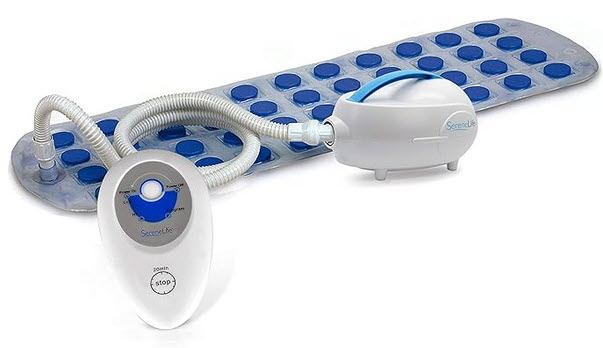Fibromyalgia Basics
Spa Therapy at Home
Using Heat & Minerals for Fibromyalgia

Spa therapy is a multi-billion-dollar industry that claims to relieve pain through massage, seaweed wraps, and hot mud baths—which are the focus of numerous clinical studies for fibromyalgia. Cleopatra, the “woman who time could not wither,” often frequented the Dead Sea around 40 BC to reap the benefits of the hot, mineral rich water. Naturally, it begs the question: Is this how fibromyalgia used to be treated before modern medicine?
Sixteen studies show balneotherapy, a term for bath therapy, produces symptom relief in fibromyalgia patients.1 The trials used 20-30 minutes of various hot bath therapies five days a week for two to three weeks. All 16 experiments showed significant improvements in pain and function. In fact, the benefits usually last three to six months after the therapy ends. No drug works this well, so why is moist heat combined with minerals so beneficial?
How it Works
Patients in most studies did not use simple hot bath water. The minerals found in the spa water are high in magnesium, sulfur, and potassium. Theoretically, this draws out toxins or oxidating chemicals from the tissues, which irritate nerve endings to cause pain. However, the addition of these salts may be optional because the evidence for heat (hot water or mud) is overwhelming.
Hot water produces analgesia (pain relief) by targeting the heat sensors in the skin to raise your threshold for pain. But that’s not all. Warm water soothes sore muscles by helping them relax, reducing both spasm and stiffness. Heat also improves circulation, and the buoyancy of water helps reduce pressure on your achy muscles. But a spa therapy program is believed to offer additional health benefits for people with fibromyalgia.
Help with Hormones
Heat stimulates the release of cortisol, which works as a pain-relieving anti-inflammatory. Cortisol is low in many people with fibromyalgia, so boosting this hormone helps with pain.
Immersing your body in hot water also promotes the release of growth hormone to help repair worn out tissues. Studies show fibromyalgia patients are low in this hormone.2 In addition, various forms of heat, including sauna and mud packs, increase your body’s natural pain-relieving beta-endorphins.
“This increase in beta-endorphin explains the analgesic and anti-spastic (reduced stiffness) effect of spa therapy,” says Giacomo Guidelli, M.D.3 He points out that the endorphin effect is rapid, but blood levels drop soon after you get out of the spa. So, the long-term benefits of a spa therapy program for fibromyalgia are not related to endorphin production.
Reduces Stiffness
Everyone getting out of a whirlpool feels more limber. But is it the heat or the jet-like hydrotherapy that relieves your stiffness? A Turkish study reveals that heat is key for reducing muscle tightness. In fact, heat loosens the muscles surrounding your lungs and makes breathing easier.
If you wake up stiff as a board every morning, submerge your body in heat. While this adds to the time required to get ready each day, you will feel better in the long run.
Quiets Pain Sensors
The nerves traveling through your muscles have sensors to detect when certain chemicals get too high. It’s a sign your muscles are overworked.
One sensor well-known for detecting burning pain responds to capsaicin, a metabolic product in the muscles. It’s the same chemical found in chili peppers that makes them hot and burns your mouth. When these sensors are triggered, they tell your brain your muscles hurt. They also produce the burning sensation that occurs when you overwork your muscles.
The muscle nerves in fibromyalgia patients appear to contain too many “chili pepper” type of sensors.4 Researchers suspect this makes your muscles hurt even when they are not overworked. However, you can “chill” them out by submersing your muscles in soothing heat on a regular basis. It gets these sensors to back down and reduce pain even when you are not in the tub.
Boosts Immune Function

Recent studies show the immune system plays an important role in generating the symptoms of fibromyalgia. So, if hot water therapy reduces your pain, does this mean it also produces changes to your immune system? Yes.
Years ago, one study showed spa therapy reduced the immune system’s production of pain-promoting substances in fibromyalgia.5 More recently, researchers showed that proteins known to fight inflammation are increased after four weeks of hot water therapy.6
Counters Oxidizing Chemicals
Your metabolic processes produce oxidizing chemicals called free radicals. If these chemicals stockpile, they irritate nerve endings and cause pain. However, antioxidants manufactured by your body, as well as those you ingest, detoxify the oxidants and this counters their detrimental effects. Balneotherapy reduces the production of oxidizing chemicals, and it corresponds to reductions in fibromyalgia symptoms.7
The mineral effects of spa therapy for fibromyalgia are less understood. However, researchers believe they work as antioxidants by drawing out chemical waste products from the tissues. Natural spa waters are high in magnesium, a potent antioxidant that happens to be low in people with fibromyalgia.
Better Sleep
Sitting in a hot tub for 30 minutes at night reduces the time to fall asleep and increases the duration spent in slow wave, restorative sleep.8 In fact, benefits of hot water or spa therapy increase with regular nightly treatments in fibromyalgia patients. Moreover, better quality of sleep usually increases growth hormone secretion at night, which helps repair sore muscles. So, if sleep medications are inadequate or cause too many side effects, try hot water therapy.
Intermittent Vs. Daily
If you don’t have daily access to a hot tub or the time to sit in one each day, a less intense schedule still offers benefits. Researchers compared five times a week to two times a week of balneotherapy in people with fibromyalgia and the latter regimen still produced symptom relief.9
Fast Acting, Long lasting
Putting aside the resort-like environment, most bath therapy studies show long-lasting effects in people with fibromyalgia. Just two to three weeks of balneotherapy reduces fibromyalgia symptoms for up to six months.
While heat and mineral water therapies can’t replace your conventional drug treatments altogether, adding a hot bath offers additional benefits. And better yet, none of the patients in the studies showed evidence of any side effects (of course, the subjects only had fibromyalgia and other conditions might not do as well). Either way, this nondrug therapy will help you to relax while providing you with much-needed pain relief.
Although regular visits to the Dead Sea for its soothing hot mineral water are not as feasible for you as it was for Cleopatra, a bathtub or hot tub will keep you functional and halt your symptoms from winning the battle.
Do It Yourself Approaches
Get the spa effect at home without paying the hefty prices.
Saltwater Spa Bath: Add 1/3 to 1/2 cup of salt (Sea Salt, Dead Sea Salt, Epsom) to water at about 99-104°F. Soak for 20-30 minutes daily and use fine or medium grain salts that will dissolve completely in water. This prevents the jets from clogging if you use jet spa gadgets.

Tub Gadgets: Keep the water warm with a four-foot long “massage mat” that produces heated air bubbles to simulate a back massage. SereneLife is around $140 (see photo) and there are other brands as well. Purchase one that specifically heats the air; bubbles alone will cool down the water. For safety reasons, steer clear of submersible gadgets that plug into an electrical outlet.
Hot Tubs: Both stationary and portable (inflatable) hot tubs are the easiest way to heat your body and ease fibromyalgia pain. To reduce costs and save on electricity, consider a one- or two-seater. Look for models with fewer jets (the more jets, the greater the cost). Also consider last year’s model because retailers sell them at a discount. Another option is to purchase a used hot tub from a local company that refurbishes them (be sure you get at least a one-year warranty). Portable hot tubs are the least costly (under $500), but they are also less energy efficient. If you decide to purchase a hot tub, get a doctor’s prescription stating it’s medically necessary for treating your fibromyalgia pain.
Stay Current on Treatments & Research: Sign up for a FREE membership today!
Why So Many Symptoms | Medications | MusclePainRelief | Finding Drs & PTs
Spa Therapy for Fibromyalgia References
- Garcia-Lopez H, et al. Int J Biometerol 68(10):1938-1951. Free Report
- Ross RL, et al. Open Immunol J 3:9-18, 2010. Free Report
- Guidelli G, et al. Clin Med Insights: Arthritis Musculoskelet Disord 5(2):19-26, 2012. Free Report
- Light AR, et al. J Intern Med 271(1):64-81, 2012. Free Report
- Ardic F, et al. Rheumatol Int 27(5):441-6, 2007. Free Abstract
- Chadwick AL, et al. Front Pain Res 6:1526491, 2025. Free Report
- Cetinkaya FN, et al. Arch Rheumatol 35(4):506-514, 2020. Free Report
- Silva A, et al. Clinics 68(2):135-139, 2013. Free Report
- Eroksuz R, et al. Int J Biometeorol 64(3):513-520, 2020. Free Abstract
